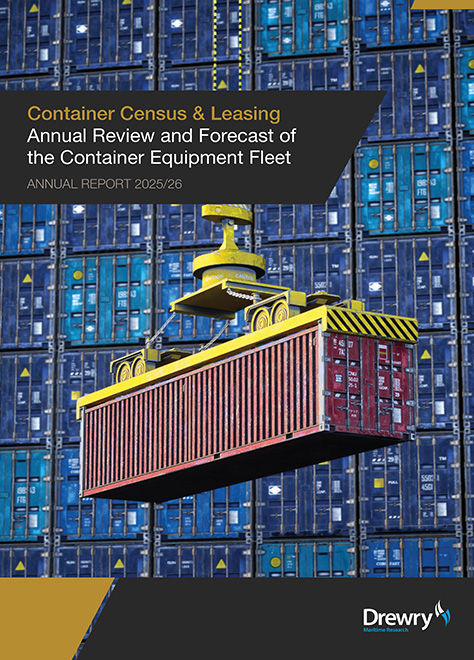News & Events
Container shipping’s equipment surplus is manageable and will recede
London, UK, 13th July 2022 – The global pool of shipping containers increased by 13% to almost 50 mteu in 2021, which was three times prior growth trend. This reflected lessors and ocean carriers ordering a record number of containers, while retiring fewer ageing units, as congestion across global supply chains meant containers were an estimated 15% to 20% less productive than in pre-Covid-19 times, according to Drewry’s recently published Container Census & Leasing Annual Review & Forecast 2022/23 report.
Drewry estimates that each container averaged 18.1 lifts in 2021 compared with 19.2 in 2020 and between 19.5 and 20.6 in the 2010s. Moreover, the number of containers per slot of vessel capacity increased by 8% in 2020 when the pandemic started and remained at this level throughout 2021.
Drewry estimates that as many as 6 mteu of surplus containers now exist in the global equipment pool. While large by historic standards, Drewry considers this surplus to be manageable for the industry.
"The delivery schedule of new ships is very strong with slot capacity expected to increase by 3.6 mteu in 2023 and by over 3.9 mteu in 2024," said Drewry’s head of container equipment research John Fossey. "With new IMO emissions regulations coming into force in January 2023 forcing some ships to sail slower, much of the surplus equipment currently in service is expected to be absorbed. In addition, there is evidence to suggest that some carriers are planning to have more buffer stock in their equipment pools, while fewer new containers will be built in the next two years."
World container fleet by operational end-use

Drewry forecasts that output in 2022 and 2023 will be much lower than last year, at 3.9 mteu and 2.4 mteu respectively, with replacement accounting for most of the orders. While newbuild and second-hand prices will fall, a return to the very low prices of 2019 is not anticipated as manufacturers are expected to manage their capacity and pricing strategies very carefully. Meanwhile, the secondary market remains robust and the uses to which ex-trading containers can be put to use continues to expand.
"Looking ahead, ocean carriers will be the main buyers of equipment over the next two years with lessors then taking control again, raising their share of the pool to 54% by 2026," added Fossey. "Moreover, per diem rates and investment cash returns will general be higher over the forecast period than in the past five years."
Container Equipment Census and Leasing 2023-24
Drewry’s annual review of the container equipment and leasing industry is based on a global census of fleet owners and a diverse range of forecasts unique to Drewry. It provides a level of detailed analysis and expert commentary not found elsewhere and is also available as an annual subscription package with the Container Equipment Forecaster which provides quarterly market updates as well as our latest forecasts.
- Detailed assessment of the global container fleet, including fleet structure and 5-year forecasts
- Extensive profiling across all main equipment types including dry, refrigerated, regional and tank container fleets
- Comprehensive ownership analysis - current structure and forecasts
- Assessments and 5-year forecasts of newbuild and secondhand pricing, leasing rates and investment cash returns
- Estimates and forecasts of smart device installation rates
Find out more
Key Contacts
© Copyright 2025 | Drewry Shipping Consultants Limited. All Rights Reserved. Website Terms of Use | Privacy Policy



